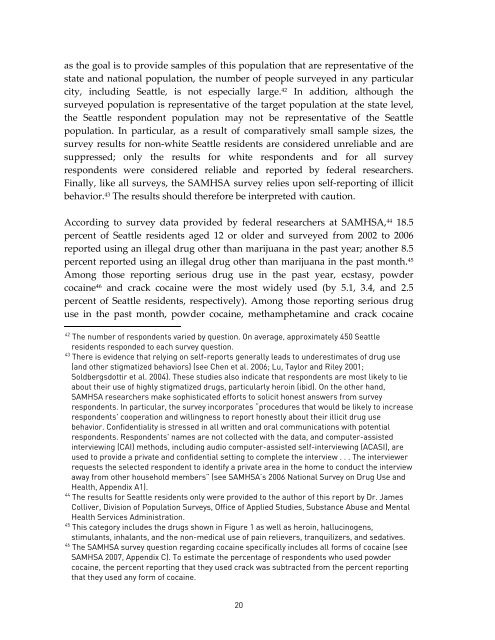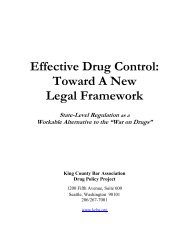RACE AND THE ENFORCEMENT OF DRUG DELIVERY LAWS IN ...
RACE AND THE ENFORCEMENT OF DRUG DELIVERY LAWS IN ...
RACE AND THE ENFORCEMENT OF DRUG DELIVERY LAWS IN ...
Create successful ePaper yourself
Turn your PDF publications into a flip-book with our unique Google optimized e-Paper software.
as the goal is to provide samples of this population that are representative of the<br />
state and national population, the number of people surveyed in any particular<br />
city, including Seattle, is not especially large. 42 In addition, although the<br />
surveyed population is representative of the target population at the state level,<br />
the Seattle respondent population may not be representative of the Seattle<br />
population. In particular, as a result of comparatively small sample sizes, the<br />
survey results for non-white Seattle residents are considered unreliable and are<br />
suppressed; only the results for white respondents and for all survey<br />
respondents were considered reliable and reported by federal researchers.<br />
Finally, like all surveys, the SAMHSA survey relies upon self-reporting of illicit<br />
behavior. 43 The results should therefore be interpreted with caution.<br />
According to survey data provided by federal researchers at SAMHSA, 44 18.5<br />
percent of Seattle residents aged 12 or older and surveyed from 2002 to 2006<br />
reported using an illegal drug other than marijuana in the past year; another 8.5<br />
percent reported using an illegal drug other than marijuana in the past month. 45<br />
Among those reporting serious drug use in the past year, ecstasy, powder<br />
cocaine 46 and crack cocaine were the most widely used (by 5.1, 3.4, and 2.5<br />
percent of Seattle residents, respectively). Among those reporting serious drug<br />
use in the past month, powder cocaine, methamphetamine and crack cocaine<br />
42 The number of respondents varied by question. On average, approximately 450 Seattle<br />
residents responded to each survey question.<br />
43 There is evidence that relying on self-reports generally leads to underestimates of drug use<br />
(and other stigmatized behaviors) (see Chen et al. 2006; Lu, Taylor and Riley 2001;<br />
Soldbergsdottir et al. 2004). These studies also indicate that respondents are most likely to lie<br />
about their use of highly stigmatized drugs, particularly heroin (ibid). On the other hand,<br />
SAMHSA researchers make sophisticated efforts to solicit honest answers from survey<br />
respondents. In particular, the survey incorporates “procedures that would be likely to increase<br />
respondents' cooperation and willingness to report honestly about their illicit drug use<br />
behavior. Confidentiality is stressed in all written and oral communications with potential<br />
respondents. Respondents' names are not collected with the data, and computer-assisted<br />
interviewing (CAI) methods, including audio computer-assisted self-interviewing (ACASI), are<br />
used to provide a private and confidential setting to complete the interview . . . The interviewer<br />
requests the selected respondent to identify a private area in the home to conduct the interview<br />
away from other household members” (see SAMHSA’s 2006 National Survey on Drug Use and<br />
Health, Appendix A1).<br />
44<br />
The results for Seattle residents only were provided to the author of this report by Dr. James<br />
Colliver, Division of Population Surveys, Office of Applied Studies, Substance Abuse and Mental<br />
Health Services Administration.<br />
45<br />
This category includes the drugs shown in Figure 1 as well as heroin, hallucinogens,<br />
stimulants, inhalants, and the non-medical use of pain relievers, tranquilizers, and sedatives.<br />
46 The SAMHSA survey question regarding cocaine specifically includes all forms of cocaine (see<br />
SAMHSA 2007, Appendix C). To estimate the percentage of respondents who used powder<br />
cocaine, the percent reporting that they used crack was subtracted from the percent reporting<br />
that they used any form of cocaine.<br />
20

















